"Cherishing Little Steps - A Haven for Baby and Family Journeys"
Infant Car Seat
When it comes to infant car seats, ensuring your baby's safety is paramount. The meticulous selection of a car seat with the right features and installation is crucial, but have you ever considered the impact of the rear-facing position? This key factor in infant car seat safety is often overlooked, but its benefits are undeniable. By understanding the significance of this positioning, you can make informed choices that prioritize your little one's protection on the road.
Importance of Infant Car Seats
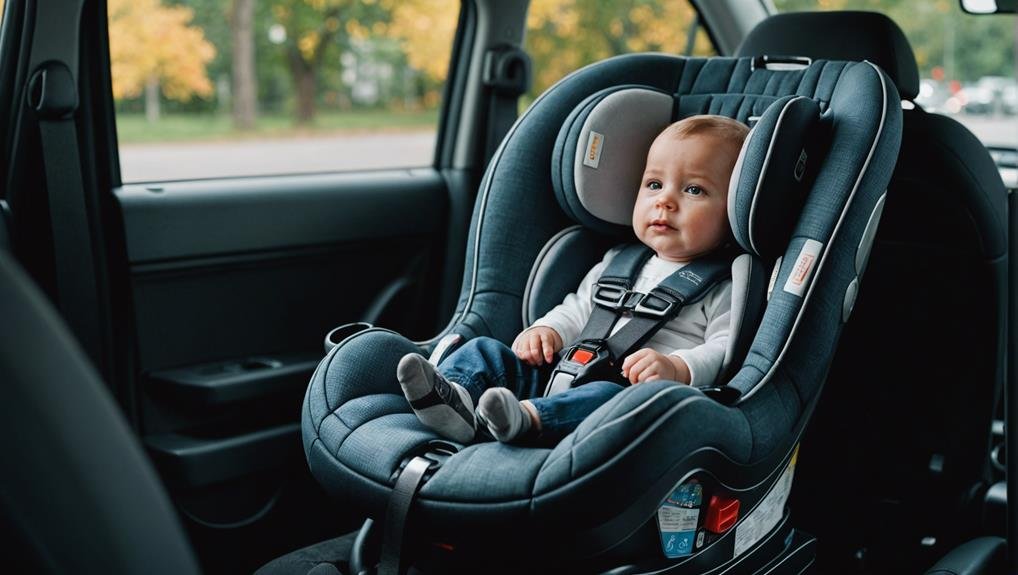
Using an infant car seat is crucial for ensuring the safety of your baby while traveling in a vehicle. Not only is it a legal requirement in most places due to car seat laws, but it also plays a significant role in protecting your child in the event of a crash. Proper education on how to install and use the car seat is essential to maximize its effectiveness.
Beyond safety, the impact of using an infant car seat on child development is noteworthy. By providing a secure and comfortable environment during car rides, an infant car seat can contribute to a sense of safety and well-being for your baby. This can lead to a more positive association with car travel, promoting a healthier mindset towards transportation from a young age.
Ensuring that your infant is securely strapped into an appropriate car seat not only meets legal requirements but also fosters a safe and nurturing environment that positively impacts your child's development.
Safety Features to Look For
When selecting an infant car seat, consider key safety features that prioritize your child's protection during car rides. Look for models that have undergone rigorous crash tests to ensure they meet safety standards. These tests simulate different types of collisions to evaluate how well the car seat performs in real-life scenarios.
Additionally, focus on finding a seat with excellent impact protection. This feature is crucial as it helps absorb and distribute the force of a crash, reducing the risk of injury to your baby.
Ensure that the infant car seat has a sturdy and adjustable harness system to secure your child in place properly. A five-point harness is recommended as it offers the best protection by securing your little one at the shoulders, hips, and between the legs.
Check for easy-to-use installation features such as latch connectors or seat belts that make securing the car seat in your vehicle hassle-free. By prioritizing these safety features, you can provide your child with a secure and protected ride every time you hit the road.
Choosing the Right Fit
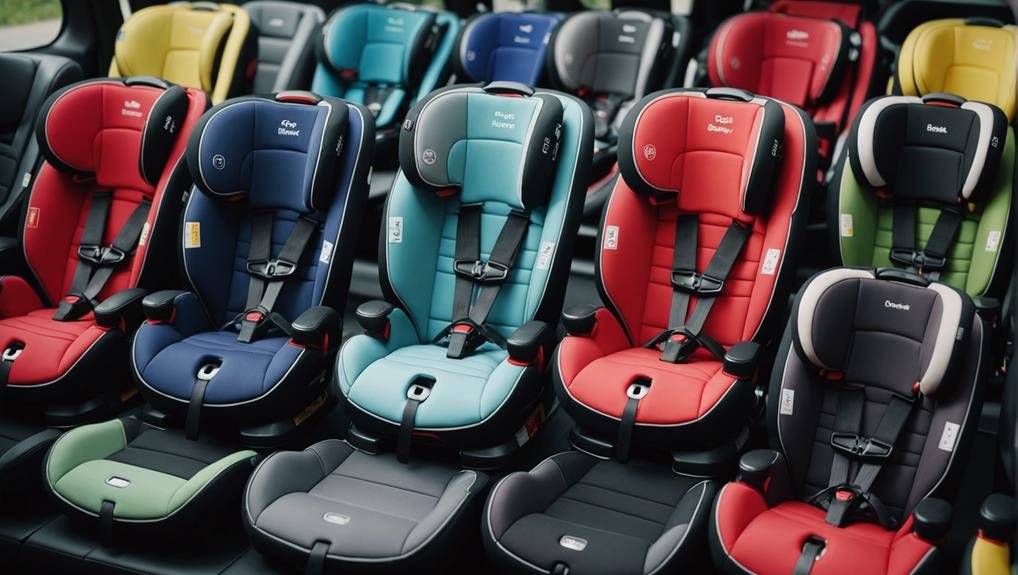
To ensure your child's safety in the car, it's important to choose an infant car seat that fits them correctly. When selecting a car seat, consider the size compatibility to ensure a snug and secure fit. Look for seats that offer features like adjustable harness positions, padding for comfort, and easy installation mechanisms. Compare different models to see which one best suits your child's size and age.
Budget considerations are also crucial. While you may find seats with a wide range of prices, it's essential to balance cost with safety features. Remember that a higher price doesn't always equate to better protection, so research and read reviews to find a seat that offers the best value.
Additionally, brand reputation plays a significant role in choosing the right fit. Look for well-known brands with a history of producing reliable and durable car seats. A reputable brand is more likely to prioritize safety and quality in their products, giving you peace of mind when traveling with your little one.
Installation Tips and Tricks
Ensure your infant car seat is securely and correctly installed by following these essential tips and tricks. When it comes to car seat installation, always refer to the manufacturer's instructions for specific guidance.
Start by securing the base tightly in the back seat of your vehicle using either the seat belt or the LATCH system. Make sure the base is level to prevent your baby's head from slumping forward. Double-check the angle indicator to ensure it's within the recommended range.
Next, fasten the harness straps snugly around your baby, with the chest clip at armpit level. Ensure there's no slack in the straps, and the harness is at or below your baby's shoulders.
Remember to never place the car seat in the front seat as it's safer in the rear. Adhering to safety regulations is crucial for your baby's well-being, so take the time to install the car seat correctly—it's worth the effort for peace of mind.
Rear-Facing Position Benefits
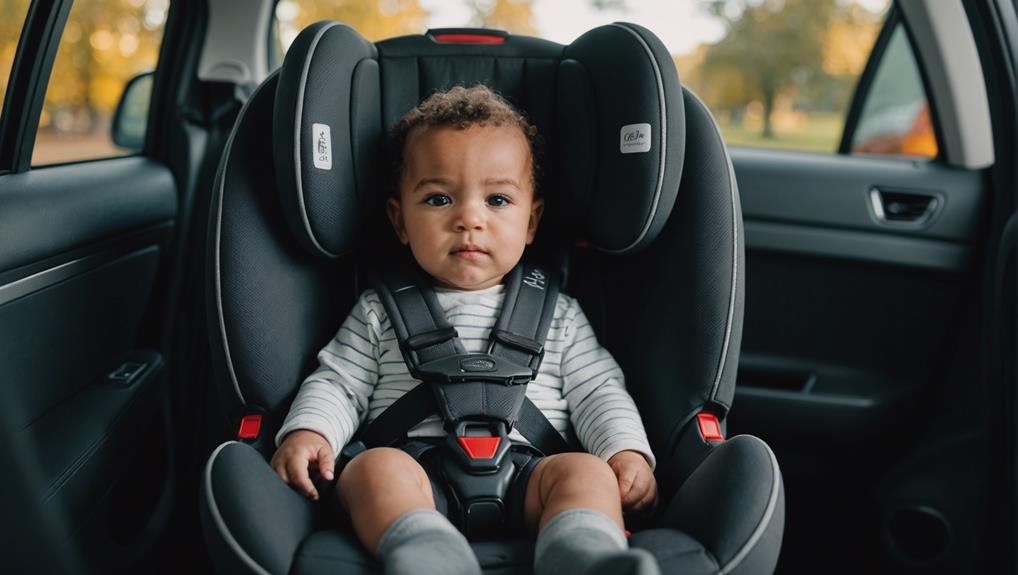
Opt for the rear-facing position in your infant car seat to maximize safety and protection for your child in the event of a collision. This position is crucial for ensuring your little one's safety and well-being. Rear-facing car seats are specifically designed to support the delicate nature of a child's developing body. They provide optimal protection for your baby's head, neck, and spine, reducing the risk of injury in the unfortunate event of a crash.
Moreover, the rear-facing position promotes better child development as it offers superior support for your baby's developing muscles and bones. The position also enhances their comfort during the ride, allowing them to rest and sleep more soundly.
Additionally, being rear-facing enables your child to have better visibility as they can see you and the surroundings, providing a sense of security and ease.
Proper Harness Adjustment
Adjust the harness of the infant car seat snugly to secure your child properly during every car ride. Harness safety is paramount in ensuring your little one's protection while traveling. To achieve optimal safety, follow these expert recommendations on proper harness adjustment techniques.
Start by placing your baby in the car seat and fasten the harness. The straps should lie flat without twists. Adjust the harness to fit snugly over your child's shoulders. You should be able to fit only one finger underneath the straps at your baby's collarbone level. Make sure the chest clip is positioned at armpit level to keep the harness straps secure.
To verify if the harness is appropriately adjusted, perform the pinch test. Try to pinch the harness webbing near your child's shoulders. If you can pinch excess material, the harness is too loose. Tighten the straps until the webbing lies flat against your fingers.
Cleaning and Maintenance Guide
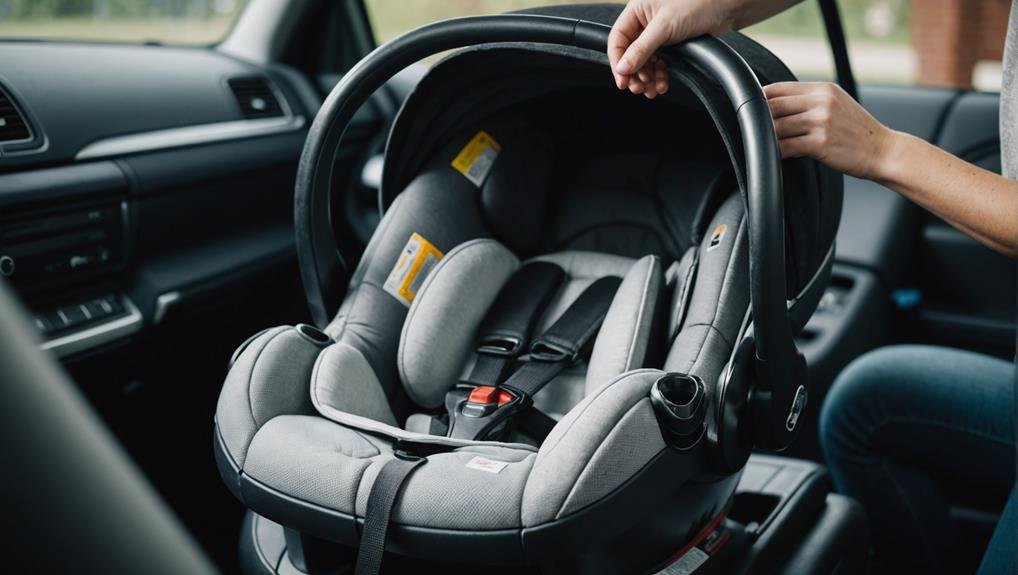
To maintain the safety and cleanliness of your infant car seat, regular cleaning and maintenance are essential. For stain removal, gently spot clean using a mild soap and water solution. Avoid harsh chemicals that may compromise the integrity of the materials.
Disinfecting is crucial, especially after illnesses or spills. Use a solution of water and vinegar to sanitize the seat, ensuring your baby's health and safety.
When not in use, store the car seat in a cool, dry place away from direct sunlight to prevent damage. Consider using storage solutions like car seat travel bags to keep it protected and dust-free.
Inspect the seat regularly for wear and tear, and promptly address any issues to ensure it functions correctly. If replacement parts are needed, contact the manufacturer to obtain genuine components. Using unauthorized parts can compromise the seat's safety.
Understanding Expiration Dates
When ensuring the safety of your infant car seat, it is important to understand expiration dates to maintain optimal protection for your child. Expiration implications and safety concerns are crucial factors to consider when using infant car seats. Over time, the materials in the seat may degrade, impacting its ability to protect your baby in the event of a crash. Extended use beyond the expiration date can pose potential risks, compromising the seat's structural integrity and safety features.
To help you grasp the significance of expiration dates, here is a table outlining the expiration guidelines for infant car seats:
| Brand | Expiration Date | Safety Recommendations |
|---|---|---|
| ABC | 6 years | Replace after expiration |
| XYZ | 7 years | Annual safety inspections |
| LMN | 8 years | Discontinue use if damaged |
Understanding these expiration dates is vital for your child's safety. Regularly checking your infant car seat's expiration date and adhering to these guidelines can help mitigate potential risks and ensure your baby's well-being during car rides.
Traveling With an Infant Car Seat
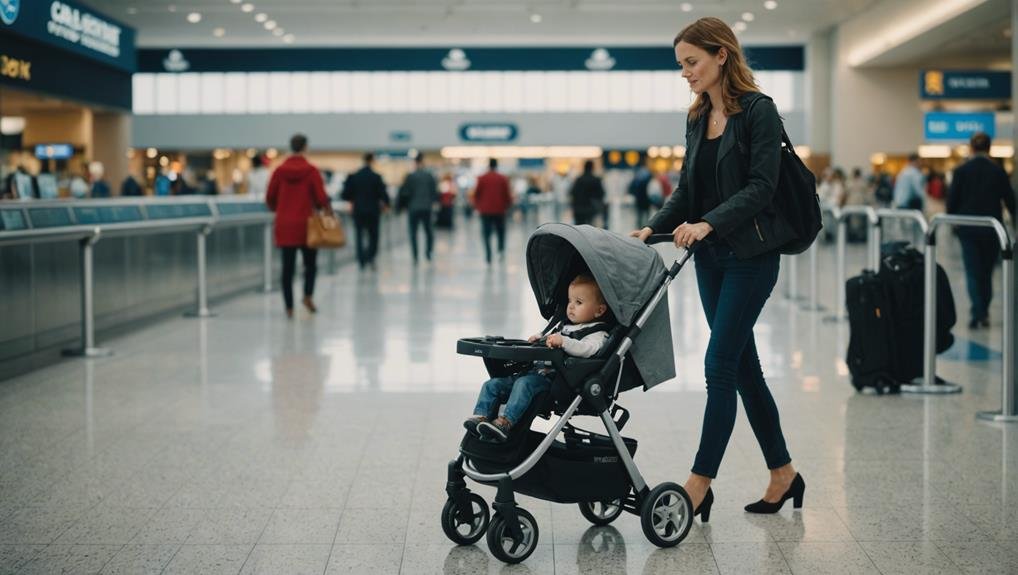
During your travels with an infant car seat, ensure it's securely installed according to the manufacturer's guidelines for optimal safety. When flying with your little one, you can bring the car seat onboard if there's an available seat, or you can check it in with your luggage. Some airlines allow the use of car seats during the flight, providing an extra layer of protection for your child.
If you prefer not to carry your infant car seat with you, many travel destinations offer rental options. This can be a convenient choice, especially if you're traveling light or going to a location where renting a car seat is feasible. Make sure to verify the quality and safety of the rental car seat before using it.
When traveling with an infant car seat, always prioritize safety by double-checking its installation and ensuring it meets the necessary standards. Whether you choose to bring your own car seat on the plane or opt for a rental at your destination, your child's safety should remain the top priority.
Common Mistakes to Avoid
Ensure you avoid these common mistakes when traveling with an infant car seat to maintain optimal safety for your child.
Firstly, always use proper buckling techniques when securing your baby in the car seat. Make sure the harness is snug, with no slack, and the chest clip is at armpit level to prevent your little one from slipping out in case of sudden stops or accidents.
Another crucial point to remember is avoiding bulky accessories in the car seat. While it may be tempting to add cushioning or strap covers for extra comfort, these can interfere with the harness's effectiveness. Bulky accessories can compress upon impact, creating dangerous gaps that compromise your baby's safety. Stick to the car seat manufacturer's guidelines and use only approved accessories that won't interfere with the harness system.
Frequently Asked Questions
Can Infant Car Seats Be Used as a Sleeping Device?
Using an infant car seat as a sleeping device is not recommended due to safety concerns. They are designed for travel, not extended sleep. For optimal comfortability factors, choose a designated safe sleep surface for your baby.
How Often Should Infant Car Seat Straps Be Replaced?
To ensure your baby's safety, remember to replace infant car seat straps according to proper maintenance and safety guidelines. Regularly check for wear and tear, fraying, or damage, and follow manufacturer recommendations for replacement intervals.
Are There Any Regulations on Decorating Infant Car Seats?
When it comes to decorating infant car seats, safety guidelines must be followed. While customization can enhance style, consider liability concerns. Opt for creative options like removable covers or non-toxic decals for a personalized touch.
Can Infant Car Seats Be Used on Shopping Carts?
When using infant car seats on shopping carts, always follow safety guidelines. Not all seats are compatible, risking accidents. Check for specific instructions from manufacturers to ensure secure attachment, safeguarding your baby.
What Is the Best Way to Store an Infant Car Seat When Not in Use?
Like a delicate flower, properly storing your infant car seat is crucial for its long-term durability. Ensure safety precautions are taken, clean regularly with mild soap and water, avoid extreme temperatures, and store in a dry, cool place.
Conclusion
As you embark on your journey with your little one, remember that an infant car seat is like a trusty guardian angel, silently watching over your precious cargo. Its safety features are like a shield, protecting your baby from harm.
By choosing the right fit, installing it correctly, and embracing the rear-facing position, you're ensuring a smooth ride filled with peace of mind.
So buckle up, and let your infant car seat be your constant companion on the road ahead.




